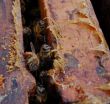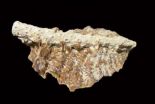(Press-News.org) It may be difficult to imagine, but pouring juice into a plastic cup can be a great challenge to a robot. While one hand holds the glass bottle firmly, the other one must gently grasp the cup. Researchers at Saarland University together with associates in Bologna and Naples have developed a robotic hand that can accomplish both tasks with ease and yet including the actuators is scarcely larger than a human arm. This was made possible by a novel string actuator, making use of small electric motors to twist strings. The robotic hand is thus powerful yet delicate and could one day be deployed as a helper around the house or in catastrophic scenarios.
„We wanted to impart our robotic hand with a broad spectrum of human traits. Its artificial muscles should be able to deliver enormous forces by simple and compact means", explains Chris May, scientist at Saarland University's Laboratory of Actuation Technology. The robotic hand was recently presented during a meeting at the Forschungszentrum Informatik in Karlsruhe. It is an example of some of the new steps taken in robotic research within the scope of the European project DEXMART. Over the past four years international scientists developed various concepts, especially focussed on increasing the versatility with which two-arm robots can be implemented. The European Union sponsored the research consortium to the sum of 6.3 million Euros.
„When robots help around the house or should save people from a burning building, they need to have hands which can grasp with strength but at the same time gently", explains Hartmut Janocha, Professor of Process Automation at Saarland University. The challenge lies in trying to make the necessary technology fit within the robotic arm such that it does not differ significantly from a human arm in terms of size and form. „We came up with a simple, yet extremely effective idea: using strings that are twisted by small, high-speed motors, we are able to exert high tensile forces within a compact space", explains mechatronic researcher May. The sensorised and controlled robotic hand is able to touch diverse objects, to grasp and lift them and place them gently in a new position. Chris May demonstrated this in Karlsruhe with a delicate Easter egg and a heavy glass bottle.
Extremely strong polymer strings enable the Saarbrücken researchers to lift a five kilogram load by 30 mm within a split second, making use of a small electric motor and a 20 cm long string. „Each robotic finger, which like a human finger is comprised of three segments, can be controlled precisely by means of the individual tendons ", describes Chris May the novel miniature actuator. The mini electric motors run at high speed and a small torque on the order of five Newton-millimetres. „The capability of the robotic hand is so near to that of humans that the vision of robots as personal assistants in the household, in the operating room as well as in industrial settings is becoming ever more realistic. We presume that the combination of small electric motors with twisted string is interesting for other applications as well", the researcher reckons.
Complementing the topics of robotic hand design, actuation and sensor development, the other DEXMART research teams addressed topics of programming by demonstration, object grasping and manipulation as well as human-robot interaction. A total of eight universities and research institutes in Germany, France, Italy and Great Britain participated in the European funded research initiative.
###
Further information is available:
http://www.dexmart.eu
http://www.lat.uni-saarland.de
Press photos of the robotic hand:
http://www.uni-saarland.de/pressefotos
Notice for radio journalists: It is possible to hold telephone interviews with the scientists at Saarland University in studio quality by means of the ISDN audio codec. Please contact the press office (+49 681 / 302-3610) to express interest in holding interviews.
Whether grasping Easter eggs or glass bottles – this robotic hand uses tact
2012-04-02
ELSE PRESS RELEASES FROM THIS DATE:
Intec Controls Inc. Selects SAP Business One from ProjectLine Solutions as its Integrated Business Management Solution to Propel Growth
2012-04-02
ProjectLine Solutions Inc. (www.projectline.ca), a leading provider of business enterprise and software solutions for small and mid-sized businesses, announces Intec Controls Inc. as one of its newest customers implementing the SAP Business One application. With offices across Western Canada, ProjectLine Solutions will be completing the implementation from its Saskatoon, SK office.
Based in Saskatoon, Intec Controls Inc. (www.inteccontrols.ca) represents a number of leading product lines in Saskatchewan and Manitoba from globally recognized manufacturers. In addition ...
Bees 'self-medicate' when infected with some pathogens
2012-04-02
Research from North Carolina State University shows that honey bees "self-medicate" when their colony is infected with a harmful fungus, bringing in increased amounts of antifungal plant resins to ward off the pathogen.
"The colony is willing to expend the energy and effort of its worker bees to collect these resins," says Dr. Michael Simone-Finstrom, a postdoctoral research scholar in NC State's Department of Entomology and lead author of a paper describing the research. "So, clearly this behavior has evolved because the benefit to the colony exceeds the cost."
Wild ...
Extreme weather threatens rich ecosystems
2012-04-02
Extreme weather such as hurricanes, torrential downpours and droughts will become more frequent in pace with global warming. Consequently, this increases the risk for species extinction, especially in bio diverse ecosystems such as coral reefs and tropical rainforests.
Human impact means that flora and fauna become extinct at a rate 100 times higher than normal. Climate change has been deemed as one of the main causes of species depletion.
A research team in theoretical biology at Linköping University in Sweden has, through the use of mathematical modelling and simulation, ...
IOM report identifies public health actions for improving the lives of those with epilepsy
2012-04-02
WASHINGTON — An estimated 2.2 million people in the United States live with epilepsy, a complex brain disorder characterized by sudden and often unpredictable seizures. The highest rate of onset occurs in children and older adults, and it affects people of all ethnicities and socio-economic backgrounds, yet this common disorder is widely misunderstood. Epilepsy refers to a spectrum of disorders with seizures that vary in type, cause, severity, and frequency. Many people do not know the causes of epilepsy or what measures to take if they witness a seizure. A new report ...
Honeycombs of magnets could lead to new type of computer processing
2012-04-02
Scientists have taken an important step forward in developing a new material using nano-sized magnets that could ultimately lead to new types of electronic devices, with greater capacity than is currently feasible, in a study published today in the journal Science.
Many modern data storage devices, like hard disk drives, rely on the ability to manipulate the properties of tiny individual magnetic sections, but their overall design is limited by the way these magnetic 'domains' interact when they are close together.
Now, researchers from Imperial College London have ...
Declines in Caribbean coral reefs pre-date damage resulting from climate change
2012-04-02
The decline of Caribbean coral reefs has been linked to the recent effects of human-induced climate change. However, new research led by scientists at Scripps Institution of Oceanography at UC San Diego suggests an even earlier cause. The bad news – humans are still to blame. The good news – relatively simple policy changes can hinder further coral reef decline.
Employing a novel excavation technique to reconstruct the timeline of historical change in coral reefs located on the Caribbean side of Panama, a team of scientists led by Scripps alumna Katie Cramer and current ...
Published study finds usage of, reccomendations for dietary supplements high among dietitians
2012-04-02
WASHINGTON, D.C. -- Registered dietitians are one of several groups of healthcare professionals who report using dietary supplements as part of their health regimen, according to a newly published study in Nutrition Journal, a peer-reviewed, online journal that focuses on the field of human nutrition. According to data from the 2009 "Life…supplemented" Healthcare Professionals (HCP) Impact Study, 74 percent of dietitians use dietary supplements regularly while 22 percent reported using them occasionally or seasonally. The data also indicated that an overwhelming percentage ...
Amyloid beta in the brain of individuals with Alzheimer's disease
2012-04-02
The deposition of amyloid beta in the brain of individuals with Alzheimer's disease is the focus of much research into both its cause and treatment.
While there may not be a consensus as to whether the deposition contributes to the disease or is a consequence of the disease, there is agreement that it is not favoured thermodynamically, meaning that something else is promoting the process.
Other proteins are often co-deposited in vivo with amyloid beta and one such protein is serum amyloid P component (or SAP). Recent evidence has suggested that SAP is elevated in Alzheimer's ...
Tales from the crypt lead researchers to cancer discovery
2012-04-02
HUNTSVILLE, Ala – Tales from the crypt are supposed to be scary, but new research from Vanderbilt University, the HudsonAlpha Institute for Biotechnology and colleagues shows that crypts can be places of renewal too: intestinal crypts, that is. Intestinal crypts are small areas of the intestine where new cells are formed to continuously renew the digestive tract. By focusing on one protein expressed in our intestines called Lrig1, the researchers have identified a special population of intestinal stem cells that respond to damage and help to prevent cancer.
The research, ...
Newly discovered foot points to a new kid on the hominin block
2012-04-02
It seems that "Lucy" was not the only hominin on the block in northern Africa about 3 million years ago.
A team of researchers that included Johns Hopkins University geologist Naomi Levin has announced the discovery of a partial foot skeleton with characteristics (such as an opposable big toe bone) that don't match those of Lucy, the human ancestor (or hominin) known to inhabit that region and considered by many to be the ancestor of all modern humans.
The discovery is important because it provides first-ever evidence that at least two pre-human ancestors lived between ...



